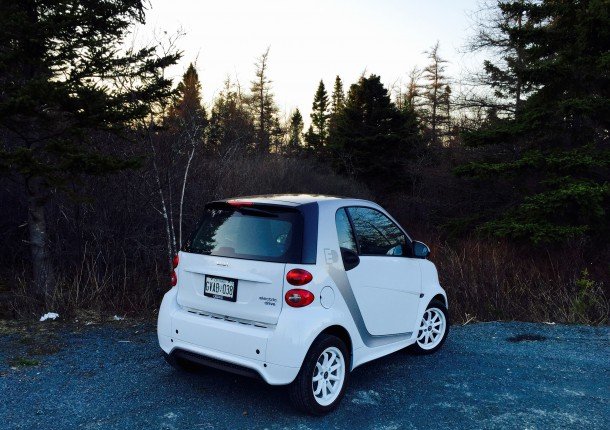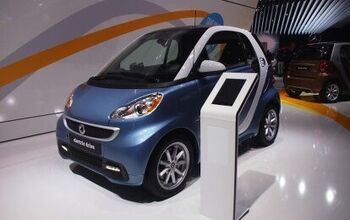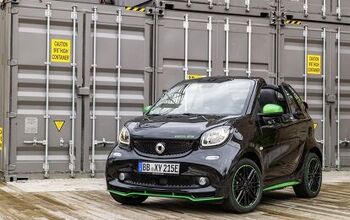2015 Smart Fortwo Electric Drive Review
I like Smarts.
It’s not a guilty pleasure, for I am not ashamed. It is a bizarre pleasure, however, lacking consistency and believability.
I’m a true blue car enthusiast with a love of V8 rumble, turbocharged torque, supercharged sizzle, manual shifters, and performance wagons. And yet, I can’t help myself: I like the way the Smart Fortwo steers. I’ve adapted to the way it wants to be shifted. I love the feeling of interior airiness. And I periodically enjoy well and truly pushing a car to its limits just to make proper forward progress. Approaching the limits in those performance cars I love? That’s a recipe for jail time.
As much as I like Smart Fortwos, my wife likes them a whole lot more. So in 2009, after our old Topaz, a new Civic, and a Santa Fe company car, she leased a second-generation model during a week of ridiculous Mercedes-Benz discounting that made the Fortwo significantly more affordable than any other new vehicle. The W451 wasn’t as efficient as the diesel model with which she fell in love in 2004, but it was thousands of dollars less expensive, much roomier inside, built better, and – in concert with the severe price cut – free to maintain. (The diesel 450 most certainly was not.)
She rarely drove the car outside the downtown core where we lived. Chief among the car’s annoyances wasn’t the transmission – the car really does force you into an unconventional acclimatization – but rather the difficulty of holding steady at the posted speed limit of 110 km/h. Fortwos prefer to settle in at an easy 130, a speed at which highway fuel consumption sharply increased. Cargo capacity and flexibility never ceased to amaze. The observed mileage far exceeded the Smart’s official ratings.
RATIONALIZING
No, not in our province, not in our lives, not even as a second car. A $30,000 two-seater with no performance credentials to speak of, no available tax rebates, lengthy charging times, and a dearth of ordinary creature comforts isn’t a recipe for success. This whole “compliance” electric car production works in a buyer’s favor with the right lease deal, in the proper U.S. jurisdiction, if they plan to operate a different primary car, and, of course, if they like Smarts.
DRIVING
More unusual is the stark difference between the way the Fortwo Electric Drive makes its way down the road in comparison with a normal second-generation Fortwo. The electric version is 16% heavier, and with the added weight settled low in the structure, the Electric Drive rides more sedately. But the steering is very heavy and rather unwilling to move far off centre.
Throttle calibration is nicely weighted, and the initial surge of torque is genuinely pleasing, as in so many electric cars. With no shifts to be completed, the Fortwo ED simply continues to build speed in a strange manner, so very unlike the normal Fortwo which, while in possession of passing power at highway speed, doesn’t exactly race down an on-ramp. The Electric Drive, on the other hand, is out of breath at higher speeds.
Brake feel is dreadful in this electric car, but the regen modes (through which you can cycle using the paddle shifters) can be so effective that one-pedal driving becomes commonplace. One-pedal driving is the best.
From a handling perspective, the weight which improves ride quality greatly reduces the feeling of agility that makes the regular Fortwo such a blast in the city. As a result, much of my reasoning for labelling the Fortwo as “fun” is lost, because this car isn’t nearly as enjoyable to hustle around town as the gas car.
RULING
A Fortwo Electric Drive and a normal Fortwo share another trait. They are most definitely acquired tastes, even for the previously indoctrinated. On day one, the Fortwo Electric Drive comes across as weird and mildly humorous. A day later, it’s simply weird. On day three, you’ve surely encountered an experience that causes it to be unfortunately weird and you’re not especially humored. Day four brings your mind around to weird but decently useful. On days five and six you’ve learned to drive the Fortwo as it wants to be driven, making it both weird and moderately fun.
By week’s end, it’s weird and likeable. But not sufficiently likeable, not with such limited range or at such a lofty price. Similarly equipped gas-fired Fortwos are at least $10,000 less, ride worse but handle better, accelerate slower but cruise more effectively, and are not limited by a charging cycle.
WAITING
The 2016 Fortwo will be slightly larger but still blissfully small. While the size causes such consternation in legions of buyers worried for their personal well-being, I always believed the Fortwo’s tidy dimensions produced odds which were ever in my favor. After all, there’s a lot less of me to hit.
Timothy Cain is the founder of GoodCarBadCar.net, which obsesses over the free and frequent publication of U.S. and Canadian auto sales figures. Follow on Twitter @goodcarbadcar and on Facebook.
More by Timothy Cain
Latest Car Reviews
Read moreLatest Product Reviews
Read moreRecent Comments
- Stan Reither Jr. Part throttle efficiency was mentioned earlier in a postThis type of reciprocating engine opens the door to achieve(slightly) variable stroke which would provide variable mechanical compression ratio adjustments for high vacuum (light load) or boost(power) conditions IMO
- Joe65688619 Keep in mind some of these suppliers are not just supplying parts, but assembled components (easy example is transmissions). But there are far more, and the more they are electronically connected and integrated with rest of the platform the more complex to design, engineer, and manufacture. Most contract manufacturers don't make a lot of money in the design and engineering space because their customers to that. Commodity components can be sourced anywhere, but there are only a handful of contract manufacturers (usually diversified companies that build all kinds of stuff for other brands) can engineer and build the more complex components, especially with electronics. Every single new car I've purchased in the last few years has had some sort of electronic component issue: Infinti (battery drain caused by software bug and poorly grounded wires), Acura (radio hiss, pops, burps, dash and infotainment screens occasionally throw errors and the ignition must be killed to reboot them, voice nav, whether using the car's system or CarPlay can't seem to make up its mind as to which speakers to use and how loud, even using the same app on the same trip - I almost jumped in my seat once), GMC drivetrain EMF causing a whine in the speakers that even when "off" that phased with engine RPM), Nissan (didn't have issues until 120K miles, but occassionally blew fuses for interior components - likely not a manufacturing defect other than a short developed somewhere, but on a high-mileage car that was mechanically sound was too expensive to fix (a lot of trial and error and tracing connections = labor costs). What I suspect will happen is that only the largest commodity suppliers that can really leverage their supply chain will remain, and for the more complex components (think bumper assemblies or the electronics for them supporting all kinds of sensors) will likley consolidate to a handful of manufacturers who may eventually specialize in what they produce. This is part of the reason why seemingly minor crashes cost so much - an auto brand does nst have the parts on hand to replace an integrated sensor , nor the expertice as they never built them, but bought them). And their suppliers, in attempt to cut costs, build them in way that is cheap to manufacture (not necessarily poorly bulit) but difficult to replace without swapping entire assemblies or units).I've love to see an article on repair costs and how those are impacting insurance rates. You almost need gap insurance now because of how quickly cars depreciate yet remain expensive to fix (orders more to originally build, in some cases). No way I would buy a CyberTruck - don't want one, but if I did, this would stop me. And it's not just EVs.
- Joe65688619 I agree there should be more sedans, but recognize the trend. There's still a market for performance oriented-drivers. IMHO a low budget sedan will always be outsold by a low budget SUV. But a sports sedan, or a well executed mid-level sedan (the Accord and Camry) work. Smaller market for large sedans except I think for an older population. What I'm hoping to see is some consolidation across brands - the TLX for example is not selling well, but if it was offered only in the up-level configurations it would not be competing with it's Honda sibling. I know that makes the market smaller and niche, but that was the original purpose of the "luxury" brands - badge-engineering an existing platform at a relatively lower cost than a different car and sell it with a higher margin for buyers willing and able to pay for them. Also creates some "brand cachet." But smart buyers know that simple badging and slightly better interiors are usually not worth the cost. Put the innovative tech in the higher-end brands first, differentiate they drivetrain so it's "better" (the RDX sells well for Acura, same motor and tranmission, added turbo which makes a notable difference compared to the CRV). The sedan in many Western European countries is the "family car" as opposed to micro and compact crossovers (which still sell big, but can usually seat no more than a compact sedan).
- Jonathan IMO the hatchback sedans like the Audi A5 Sportback, the Kia Stinger, and the already gone Buick Sportback are the answer to SUVs. The A5 and the AWD version of the Stinger being the better overall option IMO. I drive the A5, and love the depth and size of the trunk space as well as the low lift over. I've yet to find anything I need to carry that I can't, although I admit I don't carry things like drywall, building materials, etc. However, add in the fun to drive handling characteristics, there's almost no SUV that compares.
- C-b65792653 I'm starting to wonder about Elon....again!!I see a parallel with Henry Ford who was the wealthiest industrialist at one time. Henry went off on a tangent with the peace ship for WWI, Ford TriMotor, invasive social engineering, etc. Once the economy went bad, the focus fell back to cars. Elon became one of the wealthiest industrialist in the 21st century. Then he went off with the space venture, boring holes in the ground venture, "X" (formerly Twitter), etc, etc, etc. Once Tesla hit a plateau and he realized his EVs were a commodity, he too is focused on his primary money making machine. Yet, I feel Elon is over reacting. Down sizing is the nature of the beast in the auto industry; you can't get around that. But hacking the Super Charger division is like cutting off your own leg. IIRC, GM and Ford were scheduled to sign on to the exclusive Tesla charging format. That would have doubled or tripled his charging opportunity. I wonder what those at the Renaissance Center and the Glass House are thinking now. As alluded to, there's blood in the water and other charging companies will fill the void. I believe other nations have standardized EV charging (EU & China). Elon had the chance to have his charging system as the default in North America. Now, he's dropped the ball. He's lost considerable influence on what the standardized format will eventually be. Tremendous opportunity lost. 🚗🚗🚗







































Comments
Join the conversation
I got a 2013 Smart ED in January 2014 as an experiment to see if I could live with an EV. At the time they were offering nothing down, $129/month for 36 months. With our state tax incentives in Georgia for ZEV, that makes it almost free. 20% off MSRP up to $5k tax credit. We had 3 other Mercedes and I rationalized it by saying that it is technically designed by Mercedes and matched our other three silver cars. In a short amount of time, I went from my regular commuter, a 2008 ML63 AMG to driving the Smart everyday. It makes sense in heavy traffic and tiny parking garages. On days of heavy traffic I use to get an indicated 7 mpg in my ML, where the Smart would get about 3.2 miles/kWh. My daily commute costs went from $7-8/day to $0.75. I liked commuting on backroads anyways so speeds never really got higher than about 55mph. The range proved not a problem in 6 months. It's great to be able to drive around and not have to worry about how much gas/$$$ you are wasting. Then one day in April 2014, I test drove the BMW i3 and a couple months later when they were released, ended up trading my ML63. The i3 is so much better than any other EV, even the Tesla for the price. I gave my father our E500 and we got another i3 for my partner's commute. Our second i3 is an even better deal than the Smart. I paid net about $1,500 for two years of driving or about $62/month after tax incentives and discount on left over 2014 i3. Not to mention we save over $300/month in gas for my ML and about $250/month for the E500.
I had a diesel fortwo for 9 years and loved it, but the maintenance was starting to get expensive, and at 180,000 km, was nearing the stage of everything having to be replaced a second time. When i got wind of the crazy lease deals last summer, i jumped on an ED, and i'm glad i did. I loved my diesel, but i'm over the moon in love with the electric drive. It suits 90% of the driving i do, and it's a BLAST to drive. The whine of the electric motor when you stomp on the "go" pedal is as addictive as the roar of a big internal combustion engine. And the torque! In Ontario, it was a sweetheart deal on the lease. Since Mercedes-Benz Financial is technically the "owner", they applied for the rebate on the lessee's behalf, and it essentially went toward the down payment, resulting in $100/month payments. Brilliant. What i made on the sale of my original diesel went toward getting a Level 2 charger installed.